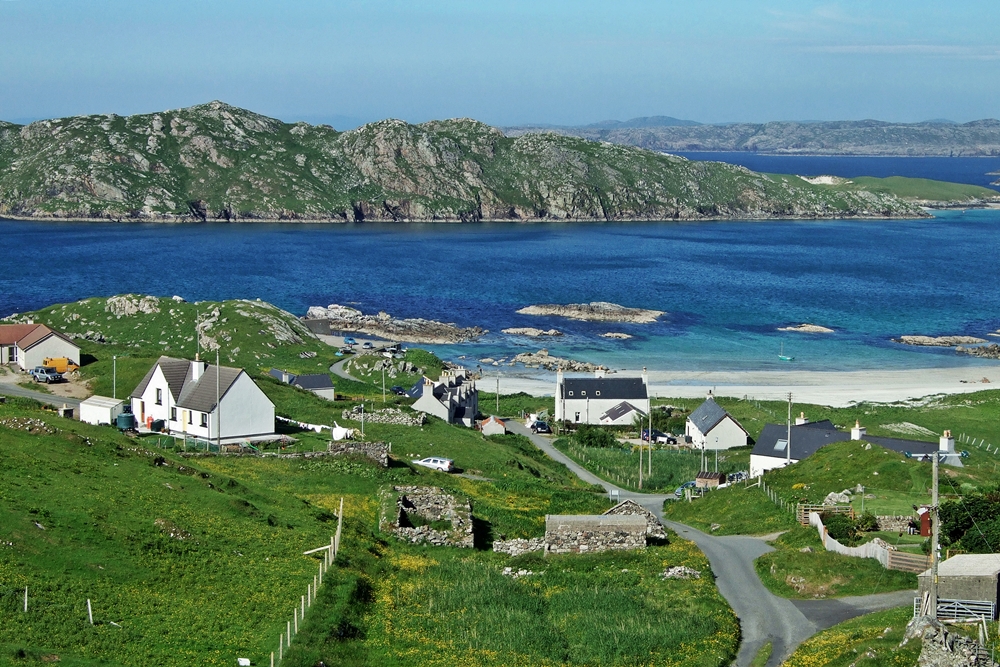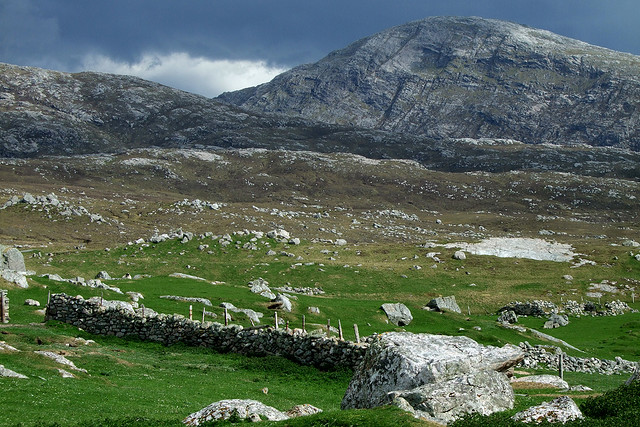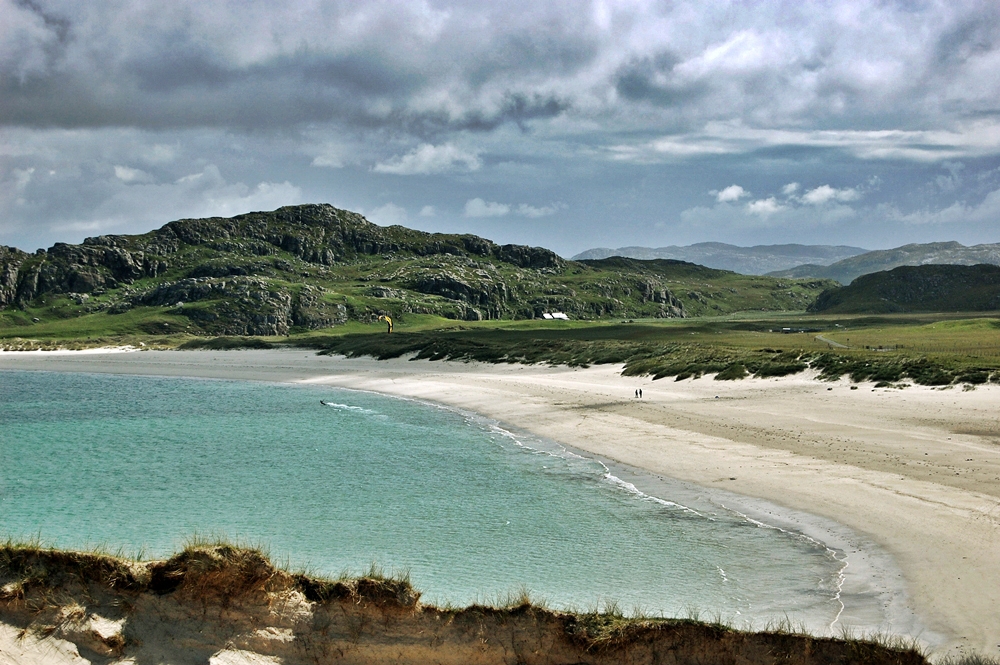Uige, by W Anderson Smith (1874, 1886)
From Lewsiana, by W Anderson Smith (1874, 1886)
UPWARDS of thirty miles from Stornoway, by Garynahine, lies the district of Uige. Although so much farther off than Shawbost or Carloway, it is nevertheless much nearer, so far as facilities for communication and elements of civilisation are concerned. Indeed, it is rather amusing to observe the airs of conscious superiority assumed by the people of this part, in their intercourse with the “barbarians” to the north of Garynahine.

A well-laden fishing-boat bound for Valtas is rocking on the beach at Loch Carloway; let us step on board and cross over on a visit to this famous district, by general acknowledgment the most picturesque in the Lews. The stout boat before the stiff breeze soon enters the narrow sound between the islands of Great and Little Bernera, on the latter of which at one time stood a chapel of the ” black ladies,” or nuns. As we proceed to the narrowest part between abrupt cliffs, with just room enough to enable a good boat to pass, under our keel may be observed extensive beds of Zostera marina, covering that portion of the sound bottom that lies opposite the snug, half-concealed, little farmhouse of the kindly “King of Bernera.”
On emerging from the sound, fine sandy beaches lie on either side, on which the sea rolls heavily, carrying with it numberless habitations of the various molluscs that entice so great a variety of fishes to the neighbourhood. In front a circle of rocky islets, mostly white with the dashing spray, seems to prevent our further progress. Slipping through between two of them, however, we are soon crossing the other branch of Loch Roag that separates Bernera from Uige. Rapidly approaching the western side of the sound, we turn south and run down the shore of Pabba Island, a great resort of wild geese. With difficulty we double the southern point of the island, and run into the little roadstead of Valtas.
On arrival one is struck with the apparent fact that in this populous district there arc plenty of men but no habitations. But when the eyes can be withdrawn from the magnificent sandy beaches stretching all around, and the neighbourhood carefully scanned for signs of human dwelling-places, a few can be with difficulty distinguished from the surrounding hillocks, amid which they are cast higgledy-piggledy. Now we have scrambled ashore, over the slippery seaweed, and are stumbling up the sharp rocks, rendered still more dangerous by the still sharper shells of the limpets and barnacles, and, at length, are following our guide to the primitive dwelling, sunk somewhere amid the rocky knolls.
The impression given is, that no one could be seen for a hundred yards in a straight line anywhere in Uige. It is all “heighs and hows,” up hill and down dale; and as few would care to build on the top of a hill in this gusty land, the dwellings are necessarily unobservable until you are close upon them. In nothing, however, do they differ from those in other parts of the island, except that more of them have rooms completely divided from the cattle by a woodenor stone partition. This shows that the people are more prosperous as a rule, of which there is no question.
The close proximity of this district to the fishing-grounds enables the men to take instant advantage of good weather in the winter, when the fish also approach nearer the shore. At the same time, as the fish always come from the west, the fishermen here procure the first attack on the shoals of fish—a very great advantage and one obtained without the severe labour necessary to those who have to cross from Carloway. Added to this, the blessed sands entice myriads of flat-fish to their vicinity, and, as it were, place in the hands of the fishermen the best bait for ling, seeing the smallest boats at any season can readily set spillers in productive fishing-grounds. This never-failing supply of bait for all kinds of fishing, the incitement to exertion of resident native curers who will not supply boats to lazy or unskilled fishermen, and the ready access to the fishing grounds, soon tell in the large takes of fish; bringing comfort to the fisher families, habits of industry to the men, who find their activity rewarded, and a general brisk energy not to bo found in the less fortunate districts.
A good many small tenant farmers add to the prosperity and activity of the place, and cause the small storekeepers to be in better circumstances, and more enterprising; while a regular postal service once a week to Stornoway, and the continued passage to and fro of merchandise, bring the people into more direct contact with civilisation than those dwelling in the less prosperous villages northward. Besides these fishing facilities and good pasturage for sheep, Uige possesses more natural features of interest than any other portion of the Lews. Its splendid sandy beaches, stretching along the coast for great distances together, have already boon mentioned, and are naturally the most prominent objects to one arriving by sea. The bold bluff of Gallon Head towards the north-west is a point worth visiting, breasting the Atlantic, as the Butt does toward the north. From this a splendid vista of sea-beaten coast is visible on either side; while seawards the Flannan Isles, or Seven Hunters, seem just beside us, and the more distant island of St. Kilda is distinctly seen, sitting solitary in the watery wastes.
North from Valtas is a fine example of those large caves with which the Hebridean coast is studded. The mouth seaward has been banked up by huge rocks fallen from above, and smaller boulders thrown up by the waves. By clambering down the cliff it may be entered, when the visitor can proceed in a great way under the fern-fringed roof, until he finds himself lost in the dark among pigeon-haunted peaks. Gladly will he return to the rays of light, thrown in through the wide opening, now like a little window far above him. There is a weird, wild feeling which creeps over the rambler in such rocky chambers that operates powerfully on the imaginative Celtic mind, producing many a tale of superstitions wonder, never absent from such spots in a Celtic land.
Turning south by the only road to Valtas, lately completed, we skirt the sea over great rolling sandy downs. A mile or two brings us to Meavaig, where the Free Church of Uige is situated, a private road a mile long leading to the minister’s house. Skirting the sea from the church, the new road enters the glen of Meavaig, between bold and shapely cliffs. This is considered the most picturesque walk in the Lews, the road winding between advancing and receding cliffs, with rugged rocky elbows seemingly just lifted from the corresponding green hollow on the opposing side, extending in a pleasantly varied series for about two miles.It reminds us much of the celebrated pass of Keimanaigh,on the road to beautiful Glengariffe.
Along the summit of the hills to the right, the old road passes, leading to the Free Church by a break-neck descent, trying even to a pedestrian, but which, we are assured, the native vehicles were at one time obliged to pass. On emerging from the glen the church of the Establishment stands on the hill, over the manse of Balnakiel. andbordering a vast sandy bay. Onwards, past several sheep farms, the road proceeds, until it halts twelve or fourteen miles off, opposite the populous little island of Scalpa [actually Scarp], adjoining the mainland of Lews, containing twenty or thirty families, mostly engaged in the lobster fishery. The sheep on the farms we are passing are exceedingly good, this being the best sheep-grazing land in the country. They ought certainly to be valuable, for the sheep on that little farm we have left behind us have replaced a hundred exported families.

But, although seemingly favourable for stock in the neighbourhood of the sea, we are no longer in a land of knolls but of mountains. Rude, bare, rocky peaks, one behind the other, stretch away to the south, and command the attention. The road clambers wearily along the vicinity of the coast, and becomes more and more irregular as we proceed. Before turning to the south we see on our right, amid green knolls, the clachan of Mangersta, whose inhabitants ere this will have been allotted fresh fields and pastures new in the vicinity of Carloway. The land they have is well suited for sheep, but their crops are rarely either grown or gathered in good condition, exposed as is their sandy soil to the full severity of the climate.
Wild cliffs stretch southward from this towards Harris, becoming more rugged as we proceed. The interior is a labyrinth of mountains rising gradually from the coast, vainly attempting to protect themselves from the blast by a thin layer of peat or moss. A mile or two from the terminus of the road there is a wayside school, attended by about fifty scholars. It is conducted in that ordinarily fatal way of an absentee teacher attending college and leaving a substitute to conduct it on a pittance. Yet, in spite of the admitted faults of the system, through the strict supervision of the Free Church minister of Uige, who takes a personal and active interest not only in all the schools but in all the scholars in his district, we found the standard respectable. The scholars had a fair average knowledge of the English language, and the rudiments of a general education, showing how the conscientious discharge of an onerous duty by one man may improve the prospects of a whole community.
We found the people of Uige generally much more conversant with English than were the other outlying districts, and the church showed a large proportion of ” comfortable ” people, rationally dressed. The children, too, were of a more refined and civilised type than we found at Ness, more resembling those about Carloway district; showing less of the rude Norse, more of the sensitive Celt.
The charm of this land—and. believe us, it has a distinct hold on the affections of all visitors as well as natives— consists in the wild and solitary, yet distinctive, beauty of sea and land. Numberless lochs set in moorland, little heather, endless rain, clachans indistinguishable from the rocks by colour or elevation; yet, as one constant visitor remarked in the late autumn, the land never looks sodreary as a leafless forest land. The sea ever gives life to the scenery, and satisfies the mental demand for breadth, thus enabling the mind to turn and make much of the lesser objects of beauty, requiring closer and more familiar observation.
Let us turn from this sea-loch of Meavaig, with the green shag, and orange-breasted goosander bobbing suddenly up on its surface, as suddenly to disappear: with guillemots and razorbills sailing slowly oceanward in soft-breasted pairs, and little Highland cattle hurrying along its beach to luxuriate on the seaweed—let us clamber up the neighbouring rocky hill, and hurry over to the sea-trending valley before the driving gale, and we shall at least see one of the attractions of Uige.

Beneath and before us stretches a half-drained loch, with the wind hurrying shadows over the yellow reeds, that now rise everywhere through the still waters, and throw their restless shadows in the blue. Beyond, the sweep of the Reef sands curves gracefully in the distance. Swarms of gulls of half-a-dozen species, among which the black-backed tyrant is conspicuous, are shrieking and squalling, tumbling and stalking all about. The blue sea is rippling quietly on the sand, and the immediate view is bounded by the circle of rocky islets that enclose the Valtas waters. A flock of gray plovers is skimming above us, wild ducks are harbouring on an islet amid the reeds, or “prospecting” quietly around it; and, as the sun throws brilliance into the colouring on sea and land, and cloudland, the kaleidoscope, turns on its varying views, we feel that Ultima Thule has not been forgotten in the creation of the beautiful.
If such a thought had for a moment possessed us, we had only to continue down to the sea over the bent-covered -sandy knolls, and view the beautifully delicate shells everywhere covering the surface. Mostly of an exquisite pink, so delicately constructed that, upon being loosened from the sand, the airy beauty is at once seized by the wind and whirled once more into the waves. Each is seated on a sandy “tee,” formed by the wind sweeping away the sand around it, as the storms of ages leave aperching boulder. Such exquisite flakes of ocean’s pink petals we have never seen elsewhere; for although the other beaches of the country are plentifully supplied with shells, none equal these. We shall leave them to be raced over by the active little Dunlins, now stepping smartly and eagerly along beside us, and bear our heavier steps, so much less suitable for such a vicinage, back to the rocks and bogs.
It is only a year or two since the road was made to Valtas, and, indeed, the crofters as a rule are averse to roads. When it was proposed to have one made to Gayshider, a little clachan some miles from Meavaig— where the people have fair lots—they were very much against it, in case the proprietor should visit them, and, finding out how comfortable they were, increase their rents! When one of the ground officers was riding on horseback along a newly made road, he bid “good day” to an old woman, a relative of his own, who was sitting by the way. “Oh, yes!” she replied, “it was a fine day before the like of you could ride past here before the like of me.”
Every real or imaginary improvement is looked upon as a “dodge” of the factor to add to the crofters’ rents; and as many of their real or imaginary rights have been ruthlessly invaded, they naturally view every new movement with suspicion. The crofters, however, calmly endure any severity of government so long as they may be left in peaceable possession of their lots ; and should heaven send them good crops of barley and potatoes, and the sea yield a plentiful harvest, they will bless the land where they can obtain fuel for the cutting and carrying, and sing dull care away over the winter’s fire.
If you would to leave a comment or get in touch with us…
You can visit our facebook page Uig Historical Society where we will be able to contact you. We have a great facebook family who are always happy to help with anything from dates, photographs and any information regarding Uig.

